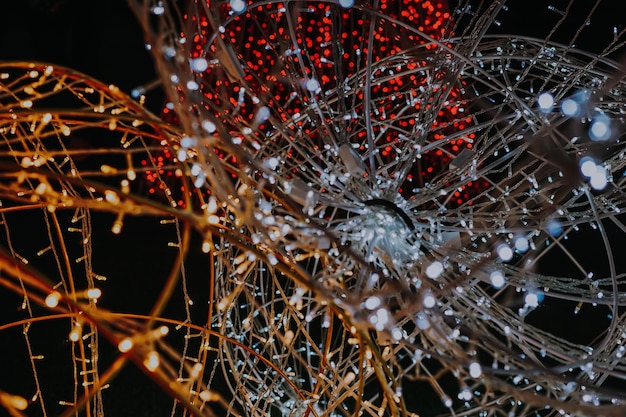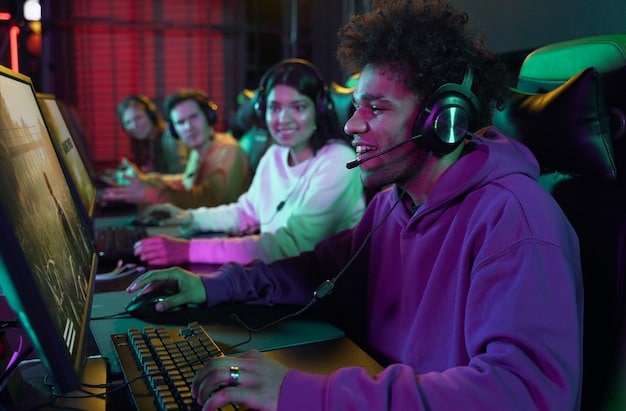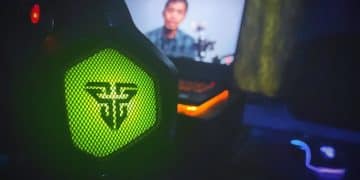Esports Anti-Cheating Measures in US: What Players Need to Know

The latest anti-cheating measures in US esports involve advanced AI, behavioral analytics, and enhanced human oversight to ensure fair play, requiring players to understand new protocols and implications for competitive integrity.
In the dynamic and competitive world of gaming, maintaining fair play is paramount. As esports continues its meteoric rise, so too does the sophistication of those seeking an unfair advantage. Understanding the latest esports anti-cheating measures in the US: what players need to know is no longer optional; it’s a fundamental aspect of competitive integrity and personal career longevity. This article delves into the strategies and technologies being deployed to safeguard the competitive landscape, examining how these advancements impact players directly.
The Evolving Landscape of Esports Cheating
The digital arena of esports, much like traditional sports, faces a constant battle against illicit advantages. Cheating, in its various forms, undermines the fundamental principles of fair competition, erodes trust, and can significantly tarnish the credibility of an entire esport. From subtle macro scripts to sophisticated aimbots and illegal communication tools, the methods employed by cheaters are as varied as they are insidious, perpetually pushing the boundaries of detection.
This relentless cat-and-mouse game necessitates an equally relentless and dynamic response from game developers, tournament organizers, and anti-cheat specialists. The measures implemented are not static; they evolve in direct reaction to new cheating techniques. This constant arms race highlights the critical need for players to be aware of the current state of anti-cheating technologies and policies, both for their protection and to ensure their compliance.
Common Cheating Methods in Modern Esports
Understanding the adversary is the first step in defense. Cheating in esports extends beyond simple exploits, encompassing a range of sophisticated methods designed to give players an undeserved edge. These can range from software enhancements to subtle behavioral manipulations, making detection increasingly complex.
- Software Hacks: These include aimbots for perfect targeting, wallhacks for seeing through obstacles, and custom overlays that provide unfair information.
- Macro Scripts: Automated sequences of actions that can execute complex commands with perfect timing, often used for rapid-fire or complex combo execution.
- Hardware Tampering: Modifying peripherals like mice or keyboards to gain technical advantages, such as reduced recoil or faster input processing.
- Account Sharing/Boosting: Allowing higher-skilled players to play on a lower-ranked account, or using external services to artificially inflate ranks.
While some methods are overt, others are designed to be undetectable by conventional means. This complexity underscores the need for multi-layered anti-cheat solutions that can identify both obvious and covert forms of foul play.
The implications of cheating reverberate throughout the esports ecosystem. Beyond direct financial losses from prize pools and sponsorships, it damages the reputation of legitimate players, teams, and the games themselves. For professional players, a cheating accusation, even if false, can be career-ending. This gravity drives the innovation in anti-cheating measures, prioritizing the sanctity of competition above all else.
Technological Advancements in Anti-Cheat Systems
The core of modern anti-cheating efforts lies in sophisticated technology. Current systems leverage an array of tools, from kernel-level monitoring to intricate behavioral analysis, designed to detect and deter malicious software and player conduct. These technologies operate silently in the background, constantly scanning for anomalies that betray unfair play. Their increasing invasiveness, while effective, also sparks ongoing debates regarding player privacy and system performance.
Kernel-Level Anti-Cheat: Deep Dive into Detection
Many leading esports titles in the US now employ kernel-level anti-cheat solutions. This form of anti-cheat operates at the deepest level of a computer’s operating system, gaining privileged access to monitor system processes, memory, and network activity. This deep integration allows them to detect even highly sophisticated cheats that might hide from user-level anti-cheat programs.
- Riot Vanguard (Valorant): A prominent example, Vanguard runs at kernel-level on system startup, aiming to detect cheats before they can even interact with the game.
- EAC (Easy Anti-Cheat): Widely adopted across various titles, EAC integrates deeply into game engines to prevent and detect cheating at a fundamental level.
- BattlEye: Another robust kernel-level solution, known for its proactive detection of unknown and custom-made cheats.
While highly effective, kernel-level anti-cheat programs raise concerns about privacy and potential system vulnerabilities. Developers assert that these systems are designed only to detect specific cheat signatures and do not collect personal user data, but transparency and trust remain key considerations for players. The ongoing dialogue between developers and the player base is crucial for balancing security with user experience.
Beyond traditional scans, advanced algorithms are being developed to identify new cheat patterns as they emerge. Machine learning plays a pivotal role here, allowing anti-cheat systems to learn and adapt, making them increasingly resilient to novel cheating methods. This proactive approach aims to shut down emerging cheats before they can gain widespread traction, protecting the competitive environment.
The future of anti-cheat technology points towards even more integrated and adaptive solutions, potentially incorporating biometric data or real-time hardware authentication. As cheats become more complex, so too will the measures to combat them, requiring a continuous commitment to research and development from the esports industry.
Behavioral Analysis and AI in Cheating Detection
Beyond detecting external software, anti-cheat measures are increasingly focusing on player behavior. Artificial intelligence and machine learning algorithms are now being trained to identify patterns of play that deviate significantly from human norms, signaling potential cheating. This behavioral approach adds a crucial layer of defense, especially against subtle forms of cheating that might bypass traditional software scans.

Spotting Anomalies: How AI Learns to Detect Cheats
AI’s role in anti-cheating is transformational. By analyzing vast datasets of legitimate gameplay, AI models establish a baseline for human performance. They then monitor live matches or review recorded gameplay for deviations from this baseline. These anomalies can include unnaturally precise aiming, impossible reaction times, consistent perfect recoil control, or movement patterns that suggest automated input rather than human decision-making.
- Aim Trajectory Analysis: AI can detect pixel-perfect adjustments or linear movements that are characteristic of aimbots rather than human hand tremors.
- Recoil Pattern Recognition: Identifying scripts that eliminate recoil entirely or reduce it to an unnatural degree.
- Reaction Time Profiling: Flagging players who consistently react to stimuli faster than humanly possible, suggesting trigger bots or other automated responses.
- Movement Pattern Irregularities: Detecting unusual pathing or synchronization that could indicate automated navigation or wallhacks.
This method doesn’t directly detect cheat software; instead, it identifies its effects on gameplay. Such systems can even identify team-based cheating, like stream sniping or illegal communication, by analyzing coordinated, suspiciously perfect actions among teammates. This layer of detection is particularly challenging for cheaters to circumvent, as it involves altering their fundamental play style to appear “human,” which often negates the advantage the cheat provided in the first place.
The strength of AI lies in its ability to adapt and learn. As new cheating methods emerge, AI models can be retrained with new datasets to recognize these behaviors, making the anti-cheat system more robust over time. This continuous learning cycle means that even if a new cheat manages to bypass initial software checks, its behavioral footprint could still lead to detection and subsequent action.
However, AI-driven detection isn’t infallible. False positives, though rare, can occur, emphasizing the need for human oversight and review of flagged cases. The goal is to refine these algorithms to minimize legitimate player disenfranchisement while maximizing cheat detection accuracy.
Human Oversight and Investigative Processes
While technology forms the backbone of modern anti-cheating measures, human intelligence and investigative rigor are indispensable. Automated systems can flag suspicious activity, but trained anti-cheat specialists, arbitrators, and community moderators play a crucial role in reviewing these flags, conducting in-depth investigations, and ultimately making determinations about player integrity. This human element ensures context is considered, and due process is followed, preventing purely algorithmic judgments.
The Role of Dedicated Anti-Cheat Teams
Major esports titles and tournament organizers employ dedicated anti-cheat teams. These teams comprise experts in game design, software forensics, data analysis, and competitive integrity. They are responsible for reviewing flagged accounts, analyzing gameplay footage, cross-referencing data points, and often conducting direct interviews or audits with players. Their expertise is vital in distinguishing between legitimate, high-skill plays and fraudulent behavior.
- Manual Review of Suspect Gameplay: Specialists meticulously review demos and VODs, looking for subtle cues that automated systems might miss.
- Data Forensics: Analyzing log files, network traffic, and system information for traces of unauthorized software.
- Community Reporting Verification: Investigating reports from other players, which often provide critical first-hand accounts.
These teams often work closely with game developers to share insights and feedback, helping to refine anti-cheat algorithms and identify new vectors for exploitation. Their collective knowledge forms a living database of cheating methods and countermeasures, continuously updated to stay ahead of the curve.
Beyond individual player investigations, these teams are also involved in broader intelligence gathering. They monitor dark web forums, hack markets, and cheat development communities to anticipate new threats. This proactive intelligence allows them to develop countermeasures before a new cheat becomes widespread, minimizing its impact on competitive play.
The human element also brings an ethical dimension to anti-cheating. Decisions on bans and sanctions require careful consideration, as they can have significant ramifications for a player’s career and reputation. Due process, evidence collection, and clear communication are paramount, ensuring that players are treated fairly and transparency is maintained where possible without revealing sensitive anti-cheat strategies.
Implications for Players: What You Need to Know
For any ambitious esports player, understanding and adapting to the current anti-cheating landscape is not just about avoiding bans; it’s about safeguarding their career and contributing to a healthier competitive ecosystem. The latest measures directly impact how players interact with games, their hardware, and even their conduct outside of official match play.
Compliance and Best Practices for Players
Players must be proactive in ensuring they remain compliant with anti-cheating protocols. This means more than just avoiding obvious foul play. It involves being mindful of software configurations, system hygiene, and even shared gaming environments. Professional players, in particular, face heightened scrutiny, and even minor infractions or associations can have severe repercussions.
- Maintain a Clean System: Regularly scan for malware and ensure only authorized software is running during game sessions.
- Understand Tournament Rules: Familiarize yourself with specific anti-cheat rules for each tournament, as they can vary.
- Protect Your Accounts: Use strong, unique passwords and two-factor authentication to prevent unauthorized access and potential account misuse.
- Be Mindful of Peripherals: Ensure all hardware meets tournament specifications and is not tampered with.
- Avoid Account Sharing: Never share your game account, as actions taken by others on your account are ultimately your responsibility.
Players should also be aware that anti-cheat systems can sometimes flag legitimate background processes or software, leading to temporary inconveniences. Communicating clearly with game support if any issues arise is crucial. Maintaining professionalism and patience during such instances can expedite resolutions.
Beyond avoiding bans, players who actively support anti-cheating efforts contribute to a more enjoyable and fair environment for everyone. This includes reporting suspicious activity, adhering to ethical standards, and promoting fair play within their communities. Ultimately, the integrity of esports rests on the collective commitment of its participants.
For aspiring pros, developing a reputation for integrity and fair play is as important as skill. Sponsors, teams, and fans are increasingly prioritizing ethical conduct, making it a critical component of a sustainable esports career. The ongoing evolution of anti-cheating measures serves as a constant reminder that success in esports must be earned legitimately.
Challenges and Future of Anti-Cheating in US Esports
Despite significant advancements, the battle against cheating in esports remains a persistent challenge. The ingenuity of cheat developers, coupled with the rapid evolution of technology, ensures that anti-cheat specialists are always engaged in an arms race. Future trends suggest an intensification of these efforts, with even more emphasis on proactive detection and collaborative industry-wide solutions.
Overcoming New Obstacles and Collaboration
Several key challenges define the current anti-cheating landscape. One major hurdle is the proliferation of hardware-based cheats, which are notoriously difficult for software-based anti-cheat systems to detect. These devices often mimic legitimate human input or manipulate game data at a physical level, bypassing traditional monitoring. Furthermore, advancements in AI itself could be weaponized by cheaters, leading to AI-driven cheats that are even harder to distinguish from human play.
- Hardware Cheats: Devices that manipulate input or network packets, posing a significant detection challenge.
- AI-Powered Cheats: Cheats that use AI to mimic human behavior, making them harder for other AI systems to detect.
- Zero-Day Exploits: Newly discovered vulnerabilities that cheaters can exploit before developers can patch them.
- Cross-Game Cheating Ecosystems: The challenge of dealing with cheat developers who distribute solutions across multiple titles.
To counteract these sophisticated threats, the future of anti-cheating will likely involve greater collaboration across the esports industry. Sharing threat intelligence, developing common standards, and even creating shared databases of cheat signatures could significantly bolster defenses. Game developers, tournament organizers, and hardware manufacturers increasingly recognize that a unified front is essential.
Another emerging area is the integration of blockchain technology and decentralized authentication. While still in its early stages, concepts like immutable player records or secure, verifiable game states could offer novel solutions for ensuring transparency and preventing account manipulation or data tampering. The push towards cloud gaming also presents both opportunities and challenges, potentially centralizing anti-cheat enforcement but also creating new points of vulnerability.
Ultimately, the objective is to create an environment where cheating is not only difficult to execute but also carries a disproportionately high risk and consequence. This involves not only technological deterrence but also robust enforcement, public awareness campaigns, and a strong cultural stance against unfair play. The ongoing dedication to these efforts will be crucial for the continued growth and legitimacy of esports.
| Key Aspect | Brief Description |
|---|---|
| 🛡️ Kernel Anti-Cheat | Deep system-level monitoring software to detect even sophisticated cheats like aimbots or wallhacks. |
| 🧠 Behavioral AI | AI analysis of player movement and aiming patterns to identify unnatural, cheat-assisted behaviors. |
| 👁️ Human Oversight | Dedicated anti-cheat teams manually review flagged cases, conduct investigations, and ensure fair process. |
| 🤝 Player Compliance | Players must secure accounts, adhere to clean system practices, and understand tournament-specific rules. |

Frequently Asked Questions About Esports Anti-Cheating
▼
Kernel-level anti-cheat operates at the deepest level of a computer’s operating system, granting it privileged access to monitor system processes for illicit software. It’s used because it provides the most comprehensive detection against sophisticated and stealthy cheating programs that can evade user-mode anti-cheat solutions, ensuring a fairer competitive environment.
▼
While AI anti-cheat systems are highly advanced, minor errors resulting in false positives can occasionally occur. However, leading anti-cheat operations typically incorporate human oversight and rigorous review processes for flagged accounts, minimizing the risk of legitimate players being unfairly banned. Developers continuously refine algorithms to improve accuracy.
▼
To protect against false accusations or bans, players should always maintain a clean computer system, avoid using unauthorized third-party software, adhere strictly to game and tournament rules, and use strong account security measures. Keeping recordings of your gameplay and communicating transparently with anti-cheat support if issues arise can also be beneficial.
▼
Hardware-based cheats pose a significant challenge because they often bypass software detection by operating outside the game’s direct view or mimicking legitimate input. While some advanced systems can identify their effects through behavioral analysis, direct detection remains complex. This is an active area of research for anti-cheat developers, leading to advanced countermeasures.
▼
Professional esports organizations typically enforce strict ethical codes and may conduct their own internal integrity checks on players. They often collaborate with game developers and tournament organizers to uphold fair play, ensuring their players and the competitive scene maintain a high standard of integrity, protecting the organization’s and the league’s reputation.
Conclusion
The relentless pursuit of fair play in US esports is a multi-faceted endeavor, driven by cutting-edge technology and human vigilance. From kernel-level anti-cheat solutions probing deep within system operations to AI-powered behavioral analysis detecting the subtlest anomalies, and robust human oversight ensuring due process, the industry’s commitment to competitive integrity is unwavering. For players, understanding these measures is not merely about avoiding penalties, but about actively contributing to a vibrant, trustworthy, and exhilarating competitive landscape where skill and dedication truly reign supreme. As esports evolves, so too will the fight against cheating, demanding continuous adaptation and collaboration from all stakeholders to secure the sport’s legitimate future.





![Mastering [your chosen topic] in PC Gaming: A Deep Dive Mastering [your chosen topic] in PC Gaming: A Deep Dive - Cover Image](https://arcanenews.com/wp-content/uploads/2025/07/arcanenews.com_11_1753889991_8be9b385_cover-360x180.jpg)